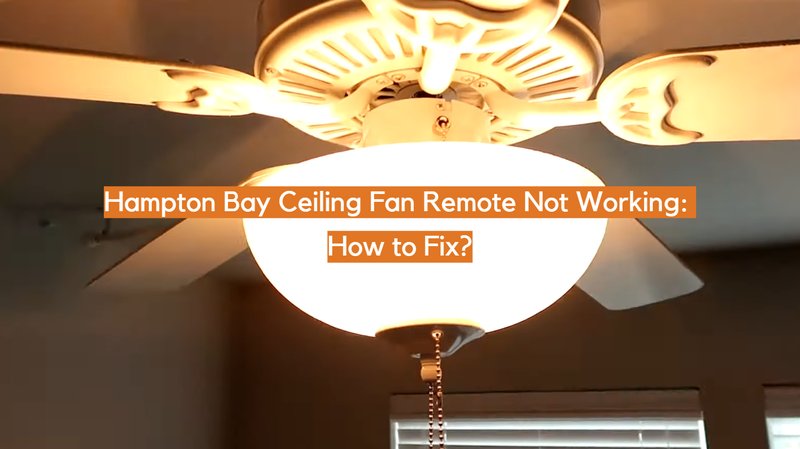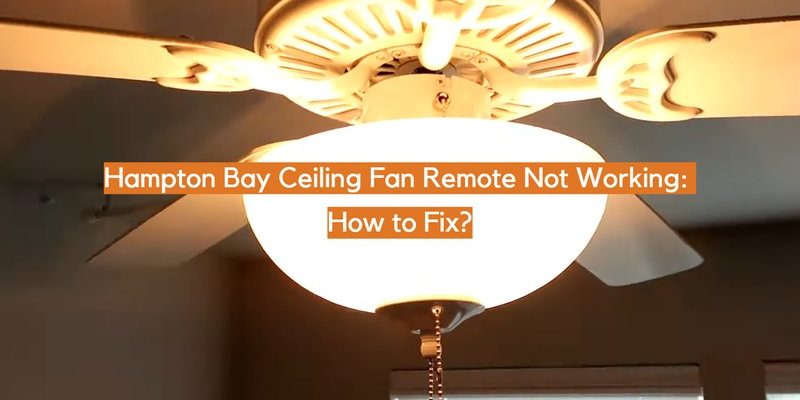
If you’ve found yourself in this spot, you’re not alone. Hampton Bay is a popular brand for ceiling fans, and they almost always come with their own remote. These little gadgets look simple, but inside there’s a tangle of code signals, pairing steps, and wireless magic that can get out of whack. When the remote won’t sync, you’re left feeling powerless… literally. Here’s the thing: most of the time, it’s a fixable issue, even if you’ve never cracked open a fan canopy in your life.
Understanding How Your Hampton Bay Ceiling Fan Remote Works
Before you start taking anything apart, it helps to know *why* a remote needs to sync with a ceiling fan. Think of your remote and fan like a walkie-talkie pair—if they aren’t tuned to the same frequency, nothing gets through. The remote sends a coded wireless signal, and the receiver in the fan listens for it. When they’re paired correctly, pressing a button tells the fan which speed to use, or whether to turn the light on or off.
Most Hampton Bay remotes use radio frequency (RF), not infrared (IR), which means you don’t have to point them directly at the fan. That also means they can sometimes get interference from other electronics, neighbors’ devices, or even other fans in your house. The pairing or “sync” process lets you match your specific remote to your specific receiver, so random remotes (or rogue signals) don’t mess with your fan.
Here’s one more detail: many Hampton Bay remotes and receivers have *dip switches*—tiny, movable switches that act as a code. If the code in your remote doesn’t match the one in the receiver above your fan, they’ll ignore each other. That’s often where sync headaches start.
Common Reasons Your Ceiling Fan Remote Won’t Sync
So why might your Hampton Bay ceiling fan remote refuse to sync? There are a handful of culprits, and each can trip up even the most tech-savvy among us. The first, and simplest, is a low or dead battery. It sounds obvious, but you’d be surprised how often a fresh battery solves the mystery. (Honestly, I’ve wasted 30 minutes on “troubleshooting” before remembering this step myself.)
Next, dip switch mismatches. If you recently replaced your remote, changed a battery, or had power issues, the dip switches may have gotten bumped or were never matched to begin with. The code has to match, or nothing will work.
Another sneaky problem: interference. If you live in an apartment building or have several fans of the same brand, overlapping radio frequencies can block signals or cause fans to ignore their remotes. Finally, there could be an actual hardware issue—like a faulty receiver in the fan or a damaged remote circuit board.
Check and Replace the Batteries in Your Remote
You might be wondering, “Isn’t the battery the first thing everyone tries?” Truth is, sometimes the battery *looks* fine, but isn’t delivering enough juice to send a strong signal. Many Hampton Bay ceiling fan remotes use common coin cell batteries (like CR2032), while some use AAAs. If your remote’s LED is dim or flickering, that’s a dead giveaway.
Here’s what to do:
- Remove the battery cover from the back of your remote.
- Take out the old battery (watch out for spring-loaded covers—those things love to launch batteries under the sofa).
- Insert a new battery, making sure the + and – sides match the markings inside.
- Snap the cover back on and test the remote with the fan.
If it suddenly syncs, you’re done! If not, at least you’ve ruled out the easiest fix. Never underestimate the power of fresh batteries.
Inspect and Match Dip Switch Codes
Let me explain the dip switch thing, because it trips up a ton of new ceiling fan owners. Inside the battery compartment of your remote, you’ll probably find a row of tiny white switches (usually 4 or 5). Your fan’s receiver—tucked above the fan’s canopy, inside the ceiling mount—has dip switches, too. The positions of these switches create a code. They all need to match, like a combination lock.
How do you check and match them?
- Kill the power to your fan at the circuit breaker. (Don’t just use the wall switch. Electricity and curiosity aren’t good friends.)
- Remove the fan’s canopy cover from the ceiling (you’ll usually need a screwdriver).
- Locate the receiver—it’s a small box with wires going in and out. Find the dip switches on it.
- Compare the positions of the dip switches inside your remote and the receiver. If they don’t match, use a tiny screwdriver or pen to flip them into identical positions.
- Replace everything, restore power, and try syncing the remote again.
The dip switch code works like a secret handshake. If even one switch is off, the remote and receiver will ignore each other completely.
Reset and Resync Your Hampton Bay Ceiling Fan Remote
Sometimes, even when the codes line up and the battery’s fresh, your fan still won’t respond. That’s where a reset and resync can help. This “hard reset” is like rebooting your phone when it freezes—it wipes out weird glitches.
Here’s how to reset and resync the remote:
- Turn your ceiling fan off at the wall switch or circuit breaker. Wait about 30 seconds, just to make sure it’s fully powered down.
- Turn the power back on.
- Within 30 seconds of restoring power, press and hold the “sync” or “pair” button on your remote (sometimes it’s the “fan” or “light” button—check your remote manual if unsure) for about 10–15 seconds.
- If the sync is successful, the fan or light will usually blink or cycle on/off to show it worked.
Not every remote has a clearly marked sync button, so check your specific model. Some Hampton Bay remotes require holding down both “fan” and “light” buttons together, or a specific sequence. If you’ve lost your manual, searching for your remote model number online usually brings up the steps.
Troubleshooting Interference and Signal Issues
RF interference can be maddening. If your neighbor’s ceiling fan remote controls your fan, or your remote seems to work only some of the time, you might be dealing with signal overlap. The usual culprits? Apartment buildings, closely spaced houses, or even other wireless gadgets nearby.
To fix this, you’ll want to change the dip switch code to something more unique. Just avoid the all-on or all-off code (those are defaults everyone uses out of the box). If you have more than one Hampton Bay fan in your house, make sure each fan/remote pair has a unique dip switch pattern.
Distance can also weaken the signal. Don’t try to control your fan from two rooms away or through several walls. Hampton Bay remotes are powerful, but they have limits. If your fan works from up close but not across the room, the receiver or remote may be failing, or there’s too much interference.
Sometimes, building materials (like metal in ceiling joists) can block RF signals. If you suspect this, try moving around the room with your remote to see where it works best.
Replacing a Broken Remote or Receiver Module
Here’s the reality: Not every ceiling fan remote problem is fixable with a battery or code tweak. If you’ve tried everything—fresh batteries, matched dip switches, resets, and there’s still no response—it could be hardware failure. Remote controls do wear out, and so do receiver modules inside the fan.
The easiest test? Try your remote with another compatible Hampton Bay fan, or borrow a friend’s working remote (with matching dip switch codes) and see if it operates your fan. If your remote works elsewhere, the receiver is probably bad. If another remote doesn’t work with your fan, the issue’s likely inside the fan.
Replacement options:
- You can buy a new Hampton Bay remote kit (which usually comes with a new receiver) from most home improvement stores or online. Make sure it’s compatible with your fan model.
- For older fans or discontinued models, generic *universal ceiling fan remote kits* can be a good alternative.
- If you’re not comfortable with wiring, consider hiring a licensed electrician. Safety first—ceiling fans aren’t worth an ER visit.
Replacing a receiver is a more involved job: you’ll be connecting wires inside the fan canopy, usually using wire nuts. Always shut off power at the breaker when working with wiring.
Comparing Universal Remotes vs. Original Hampton Bay Remotes
Now, you might be tempted by those universal ceiling fan remotes you see at the hardware store. They’re often cheaper and promise compatibility with “most brands”—including Hampton Bay. But are they a good substitute?
Original Hampton Bay remotes are designed for your specific fan model, so you get all the buttons you need (like separate light controls or airflow settings). With a universal remote, you may lose some functions, or the layout may be confusing. On the flip side, universal kits are a lifesaver if you can’t find a replacement original remote or your fan is a weird “vintage” model.
Here’s an important note: Universal kits usually come with both a remote and a new receiver, and you’ll need to swap the old receiver inside your fan. So, it’s a bit more work than just buying a replacement remote.
Here’s how they stack up:
| Original Hampton Bay Remote | Universal Remote Kit |
| Perfect match for your fan’s features | Works with most fans, including old models |
| No wiring changes needed if receiver works | Requires swapping the receiver in ceiling fan |
| May be tricky to find for older fans | Easy to find in home improvement stores |
When to Call for Professional Help
Sometimes, even after you’ve tried every trick in the book, your Hampton Bay ceiling fan remote simply won’t sync. Maybe the fan’s receiver is toasted, or the wiring looks like spaghetti. If you’re not confident popping open the ceiling mount, or if you spot burnt wires, melted plastic, or anything that looks (or smells) suspicious, it’s time to call in a pro.
Electricians deal with these problems all the time and can often diagnose a stubborn ceiling fan in minutes. They’ll ensure the wiring is safe, the receiver is working, and your remote is talking to your fan like old friends again. Yes, it costs more than a DIY fix, but sometimes peace of mind is worth it. Safety always comes first—never risk electrical shock for the sake of a fan.
If your home’s wiring is old or you see evidence of past DIY work (think wire nuts wrapped with duct tape), please, step away and call someone qualified.
Final Thoughts: Getting Your Hampton Bay Ceiling Fan Back Under Control
Fixing a Hampton Bay ceiling fan remote that won’t sync can feel like solving a tiny, infuriating puzzle. But once you break the problem down—battery, dip switches, resets, or a hardware swap—it often falls into place. The best part? That satisfying click and swoosh when your remote finally syncs again. Life gets just a bit breezier.
Remember, most issues have simple fixes, even if they seem overwhelming at first. Take your time, stay safe, and don’t be afraid to ask for help if you need it. With the right steps, your ceiling fan remote will be back on speaking terms with your fan—and you’ll be back to relaxing in comfort.
